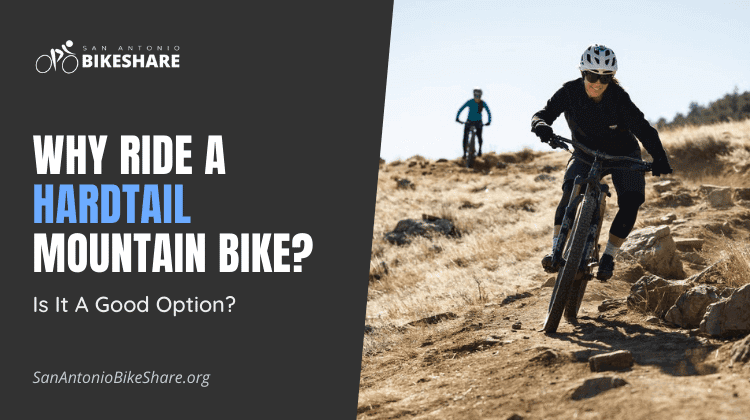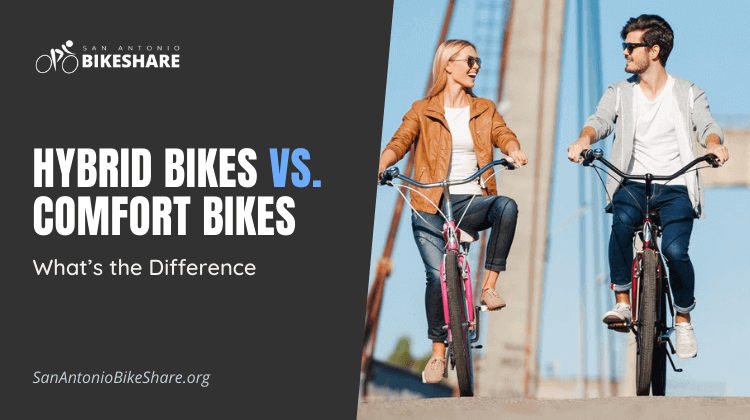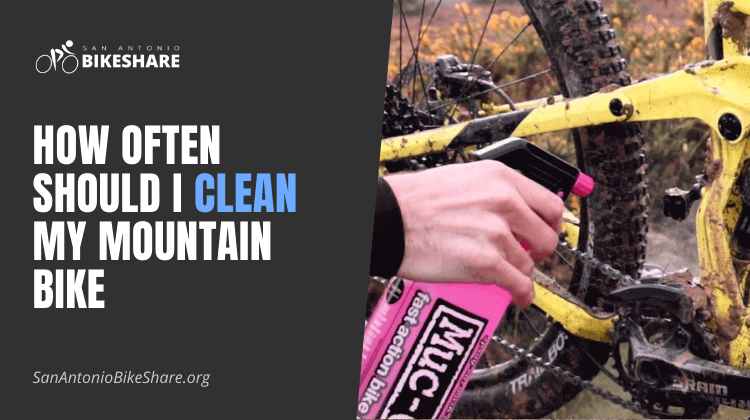Why Ride A Hardtail Mountain Bike? Is It A Good Option?
Why ride a hardtail mountain bike? Hardtail mountain bikes are among the most economical entry-level mountain bikes available, with a wide range of features and styles to fit a wide range of riding styles.
The simplicity of the bikes is part of their allure, and many riders who start out on these bikes develop a warm spot in their hearts for the thrills that only a hardtail mountain bike can provide.
Read on this article to learn about why ride a hardtail mountain bike.
Why Ride A Hardtail Mountain Bike?
A hardtail bike is a bicycle having suspension over the front wheel to help absorb shocks but no suspension to support the back wheel. Because the bike’s tail is rigid, it’s called a hardtail!
This also implies that the term “hardtail” refers to a diverse range of bikes with varying styles, designs, and features that cater to specific hardtail bikes to specific disciplines.
These disciplines include cross-country, freeride, all-mountain, gravel, hybrids, and commuting, all of which are accessible on hardtails.
When the first suspension forks were made and before full-suspension bikes were invented, hardtail mountain bikes were at the leading edge of design and performance in the cycling business.
Riders threw themselves down the mountainside on hardtails and early suspension forks in past downhill world championships, which can still be viewed on YouTube.
Hardtails have grown into multi-purpose workhorses or specialized performance machines designed for maximum speed, aggression, and control since then. The hardtail has become one of the most popular bike styles due to its versatility.
Many mountain bikers will begin with a hardtail because of its superb combination of accessibility, value, and adaptability. As a result of this, people tend to return to them for that signature feeling of comfort and rigidity.
Is It Possible to Ride a Hardtail Downhill?
A hardtail can be used for downhill biking, in a nutshell.
However, we wouldn’t recommend taking an old commuting bike or a gravel bike with a suspension fork to your local downhill course. Allow me to elaborate.
Downhill biking is widely considered to be one of the most difficult and demanding types of cycling. Full suspension hardtail downhill bikes and elite downhillers will be put to the test by the combination of speed, severe terrain, and technical complexity.
Every time they descend the mountain, even the well-equipped pros, who wear everything from neck braces to full-face helmets, take a great risk, and injuries are common.
Consider how difficult this would be on a hardtail that wasn’t designed for it. It is unlikely to go well unless you approach it with considerable caution and are a seasoned downhill biker. Certain hardtails, on the other hand, have the features and performance necessary to confidently shred downhill slopes.
Because of their ease of use and excellent performance, these hardtails, also known as all-mountain hardtails, are immensely popular among mountain bikers. They are distinguished by their aggressive geometry, heavy front suspension, thick tires, and high-performance hydraulic brakes. Many riders like hardtails because they allow them to get a better sense of the track while riding, and they believe they provide a more pure experience than more comfortable full suspension bikes.
While this is true in some situations, a hardtail will struggle to keep up with a full-suspension bike on the downhill slope and will need to be more cautious. That isn’t to say it isn’t enjoyable!
Do You Think You Can Jump a Hardtail Mountain Bike?
One of the most intriguing qualities of hardtail bikes is their versatility. If you have the right frame and components, you can jump with a hardtail, and many slopestyle and freestyle riders prefer hardtails for jumping because of their stiffness, simplicity, and durability.
When it comes to jumping, hardtails give you the advantage of being able to spring up higher off the ground, allowing you to exploit the rigidity of the bike to better pump off the jump and generate that extra momentum.
They have the disadvantage of being more difficult to land, and the transition must be timed correctly to avoid harming your wheel, frame, or yourself.
Because a hardtail has fewer parts to break than a full-suspension bike, they make excellent jumpers that can survive a lot of damage, and because the componentry is simpler, they are often easier to repair if something goes wrong.
Just remember to let go of your saddle before you start leaping, or else you’ll have a bad time.
Is it True That Riding a Hardtail Helps You Become a Better Rider?
This is something that some mountain bikers have long disputed and asserted, particularly those who got their start on an old cross-country hardtail.
A hardtail bike is regarded as a more basic, minimalist mode of transportation. You must develop abilities that you would not require on a full-suspension mountain bike because there is no rear suspension.
Hardtails, for example, give the rider considerably crisper trail input, letting you feel what the terrain is doing and learn how to adjust to the surroundings automatically based on this sense of sensation and feedback.
Full suspension mountain bikes protect you from the terrain far better, lowering the effort of difficult terrain while also reducing the amount of time you spend experiencing it.
Hardtails also encourage you to use your body to absorb shocks and use your legs as an improvised suspension in place of a rear shock, making you stronger and more confident when riding through difficult terrain.
Hardtails, in general, necessitate greater movement around the bike, searching out different positions to steady the bike’s twitchy handling. In that sense, the idea that hardtails make you a better rider could be correct.
However, it’s also likely that abilities develop with time and that riders improve naturally as they ride more. They’ll have learned so much on their hardtail that many of the skills required to ride a full bouncer will be much easier to learn when they finally graduate to full suspension mountain bikes.
Getting out and riding, regardless of the bike you pick, will make you a better rider in the end.
What Can I Do To Make My Hardtail More Comfortable?
There are a variety of techniques to improve the comfort of a hardtail, and it’s vital to employ all of them to address one of the bike’s major weaknesses.
When mounting a steep slope, the most important thing to remember is to lift your saddle. Having your saddle set low on any bike will substantially lower the amount of energy you can generate with each pedal stroke, making climbs feel much more difficult and affecting your traction due to your weight being placed too far back on the bike.
Just make sure your saddle isn’t too high; your seat should be just high enough to prevent your knee from locking out entirely at the bottom of your stroke. This allows for maximum pedaling efficiency.
A straight saddle that hasn’t been knocked off-center is another item to look for. While we’re on the subject of saddles, another important component in making things more comfortable is the seat. Many people don’t realize that not all saddles are appropriate for all types of bottoms.
It will be much more comfortable if you measure your seat and choose a saddle that fits that measurement. Switching handlebars or buying in a set of clamp-on aero bars will help you get up into the cockpit with more confidence if you’re having difficulties getting into a proper trail riding position.
Finally, a good pair of cycling shorts with a padded groin insert can come in handy!
Which is Faster: A Hardtail or a Full Suspension Mountain Bike?
This is very dependant on the type of riding you plan to do as well as the level of experience of the riders. A hardtail, on the other hand, will climb hills faster than a full suspension bike due to greater energy transmission to the back tire and reduced weight.
Professional cross-country riders choose hardtails because the combination of powerful pedaling, easy climbing, and low weight is tough to beat when climbing.
Full suspension bikes, on the other hand, go downhill quicker because their superior traction and rear suspension allow them to hurtle over tough terrain more quickly and confidently.
Full suspension bikes are used by professional downhill riders because they simply swallow rough terrain and spit out dirt in their wake.
Is It Possible To Mountain Bike With A Hardtail?
Depending on your riding style, yes and no. Hardtail bikes, on the other hand, have a number of advantages that make them a desirable alternative if you’re looking for a new bike!
Conclusion
Have you got the reasons why ride a hardtail mountain bike? In this article, not only are the reasons mentioned but the comparison of a hardtail mountain bike and full suspension mountain has been done in order to equip you with the best of knowledge so that you can make the right choice. Have a safe and happy ride!







